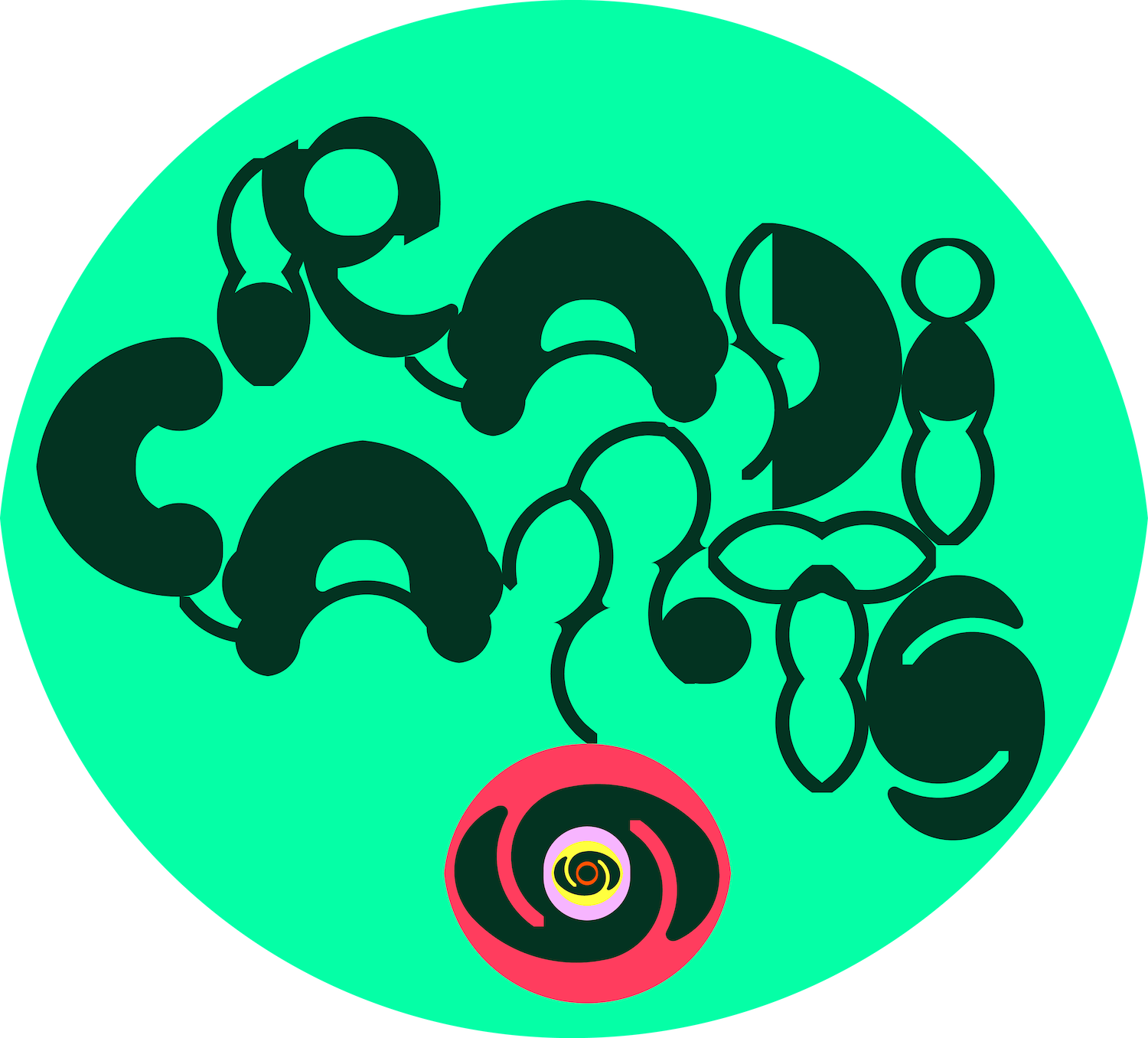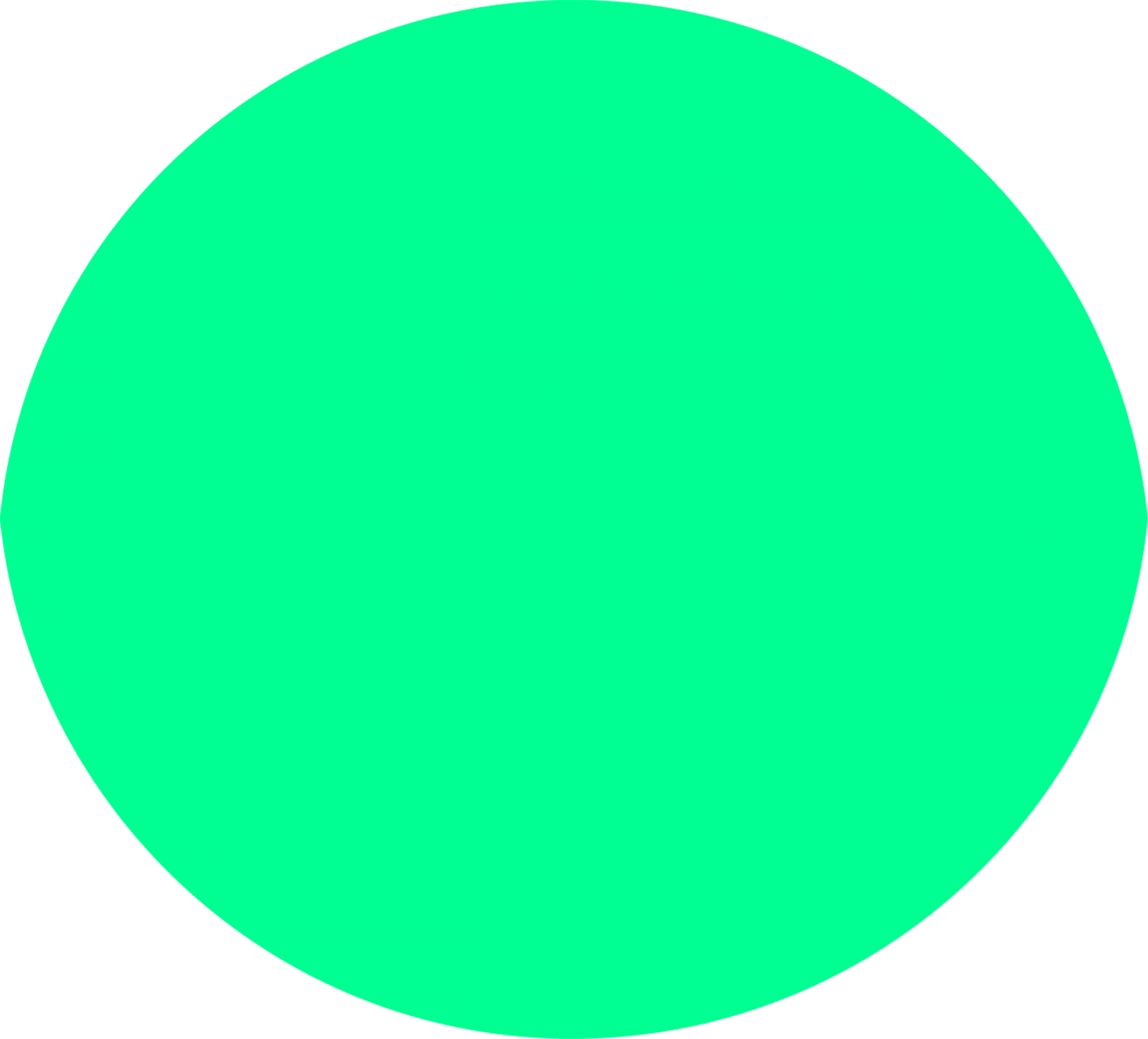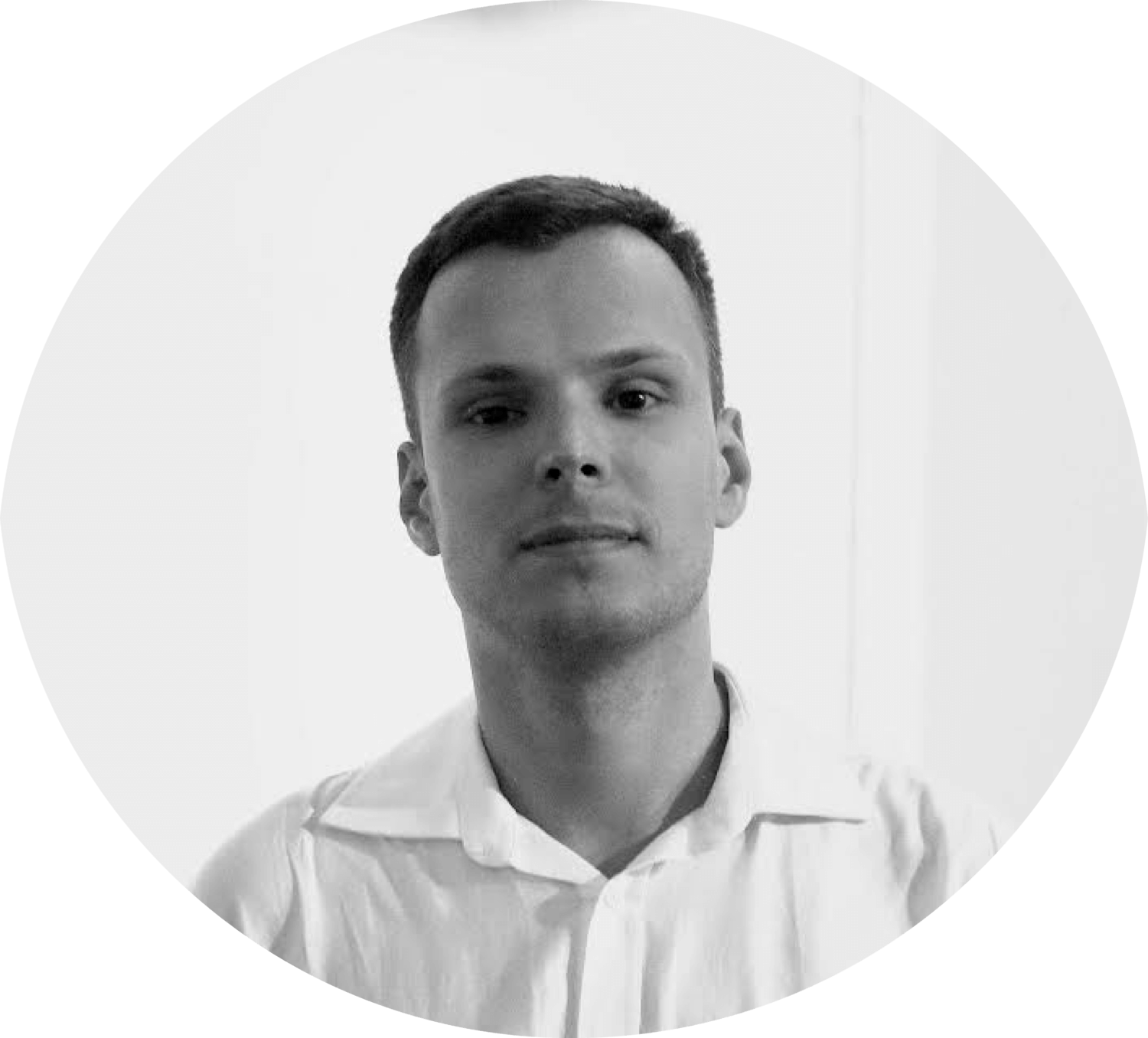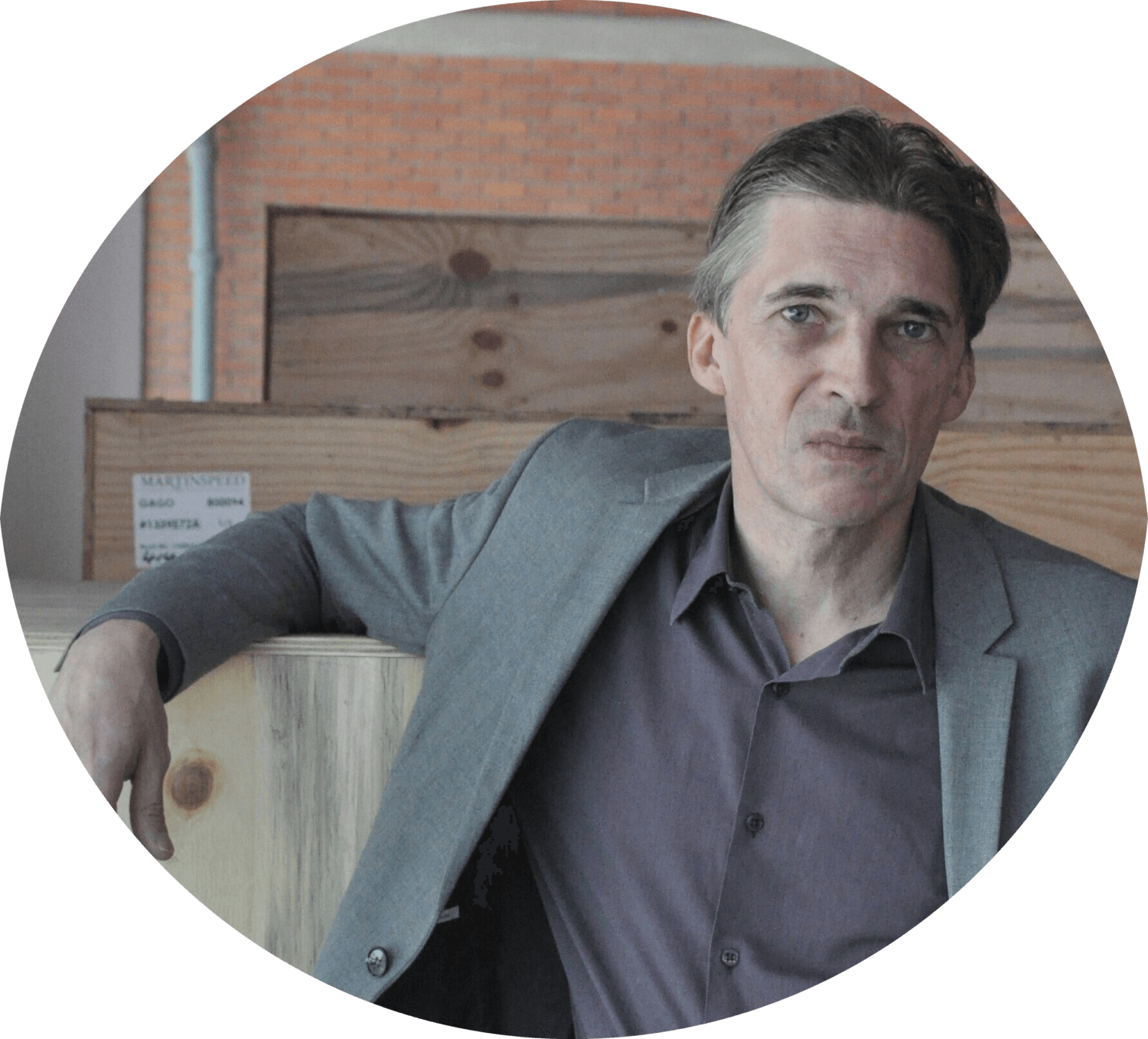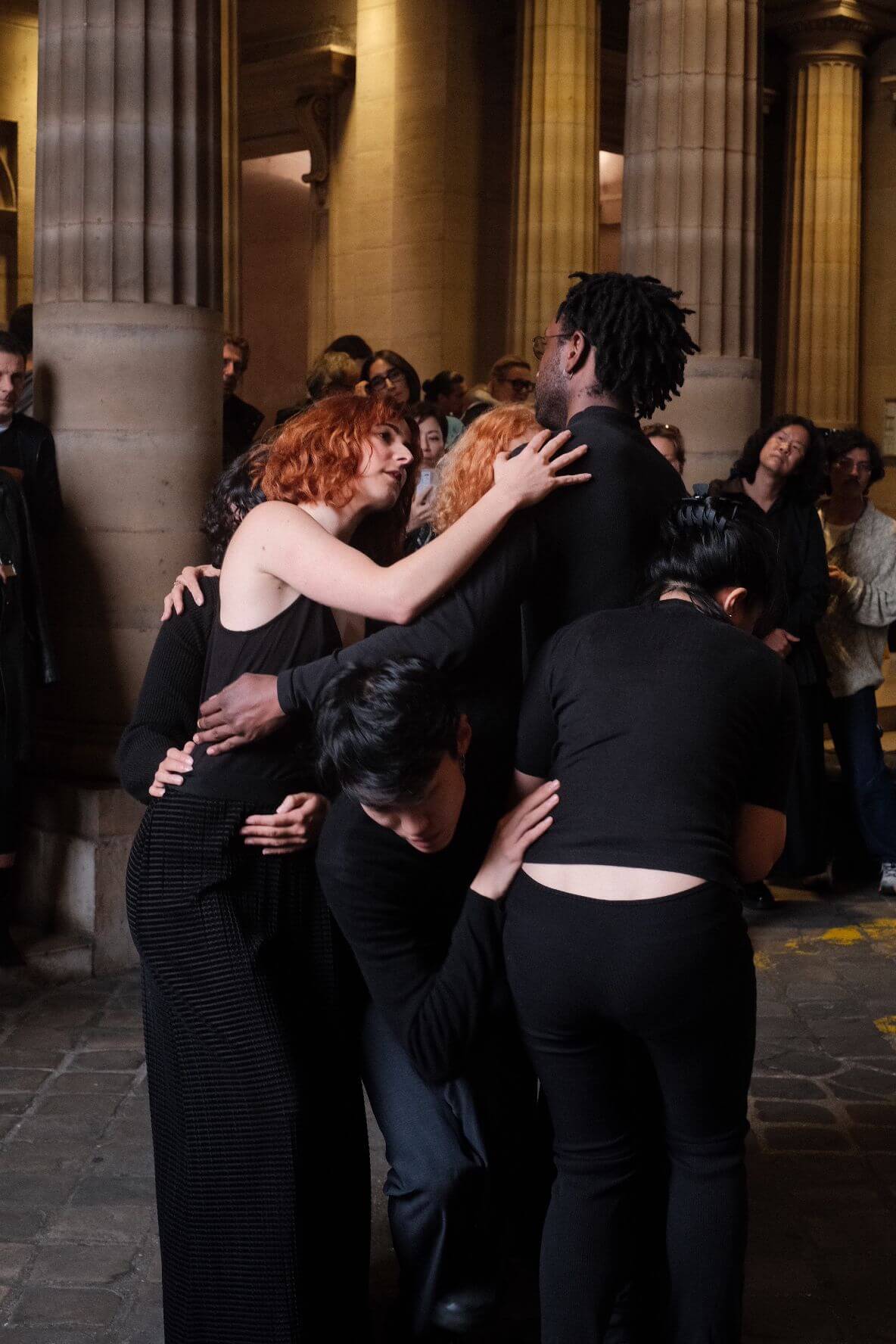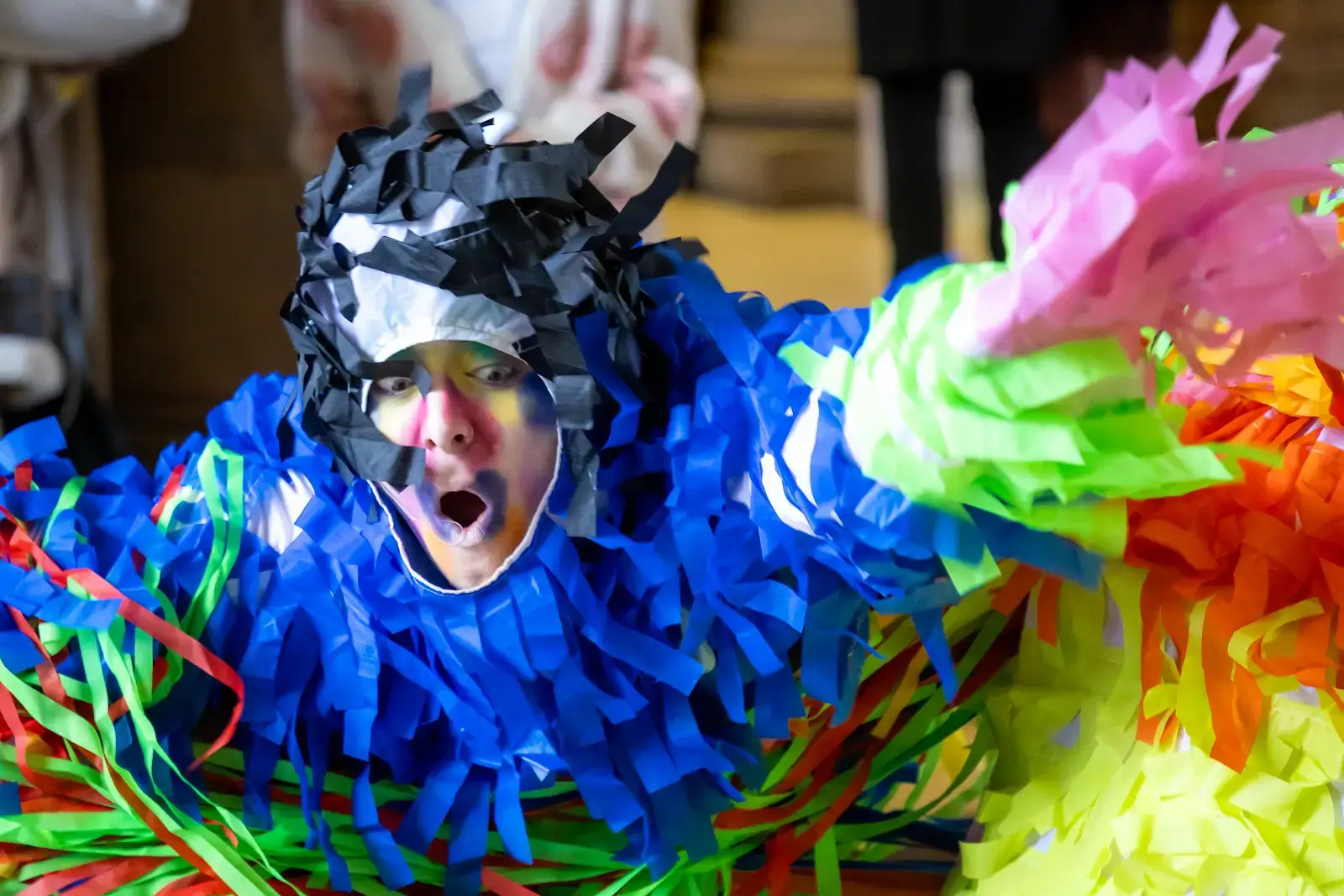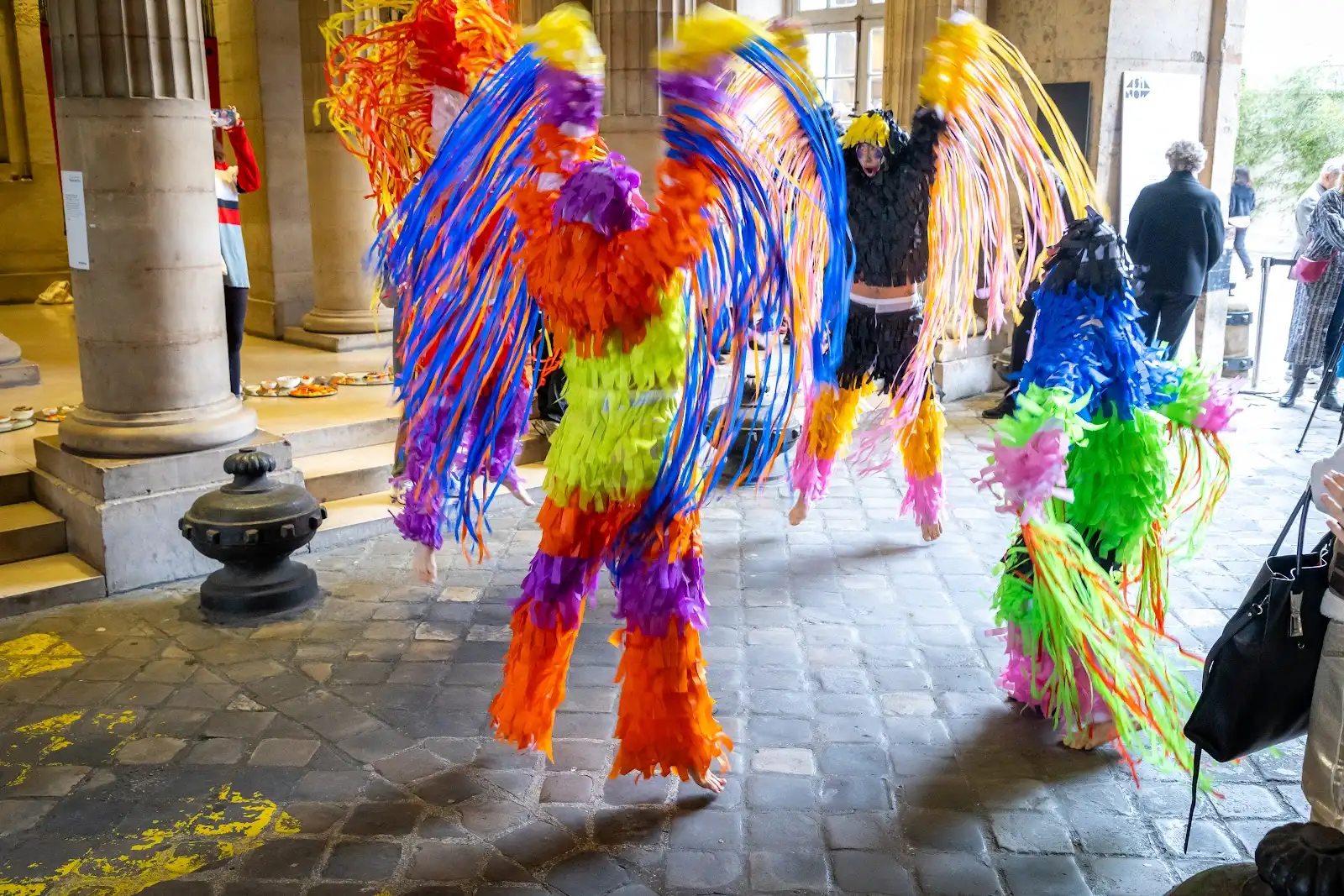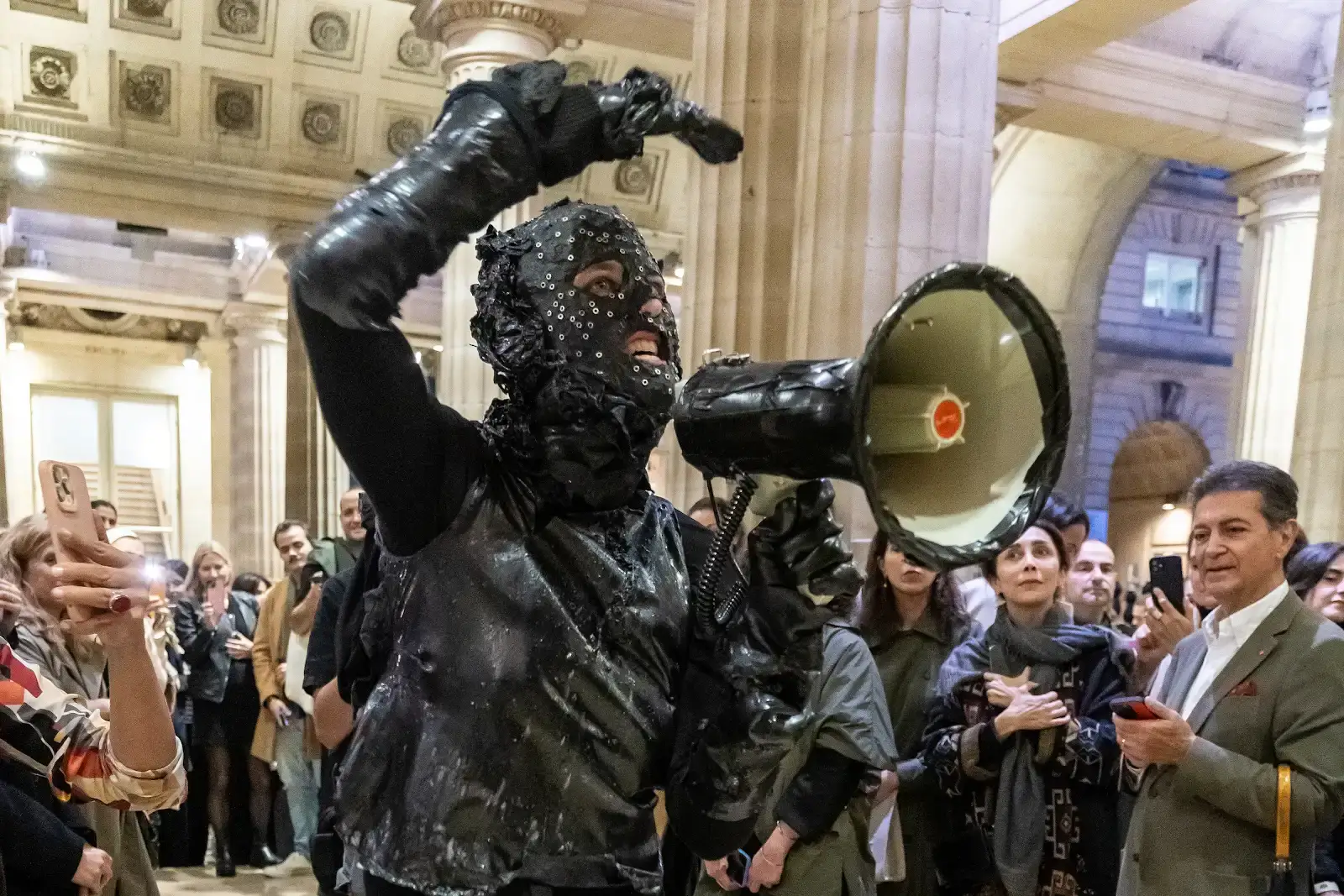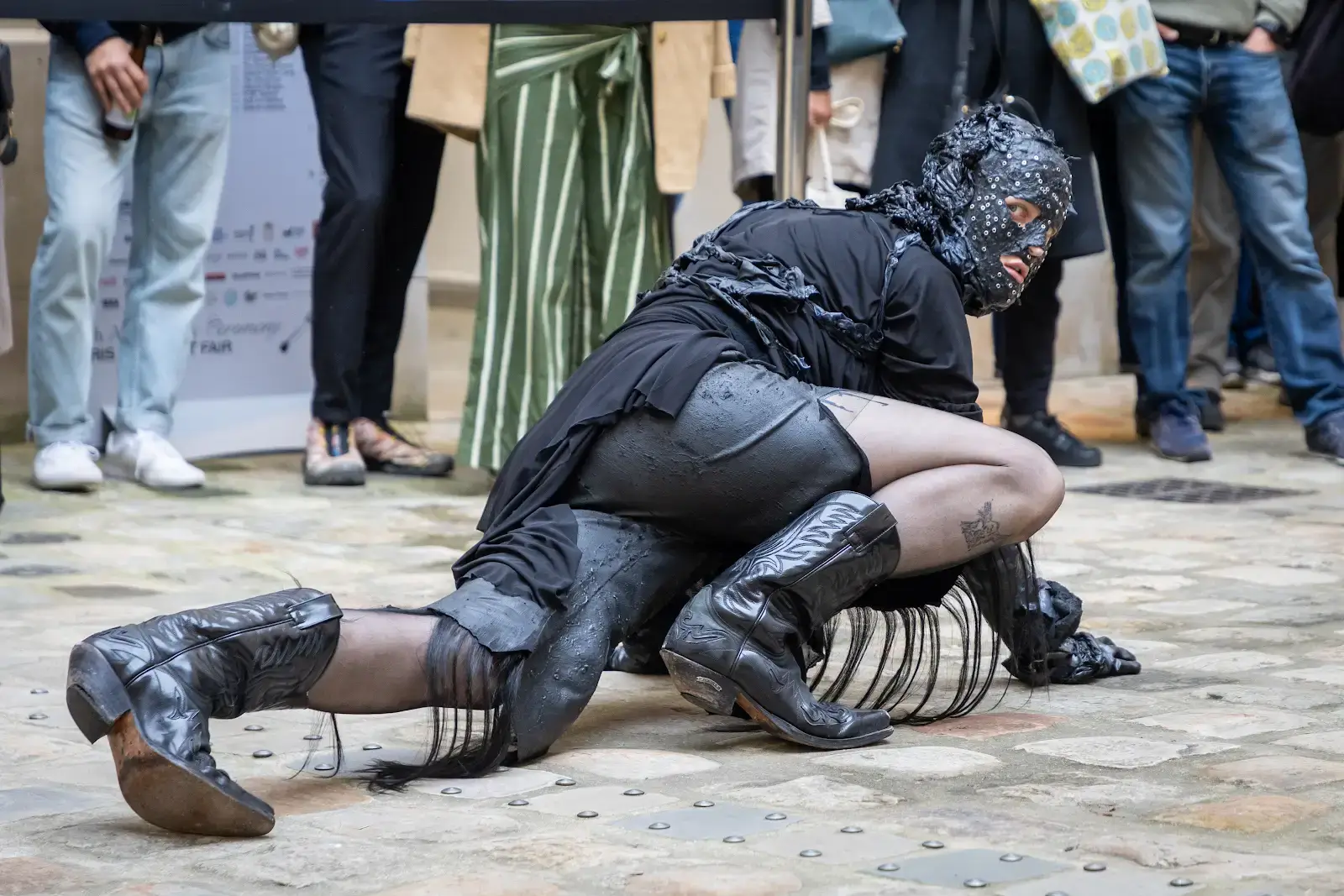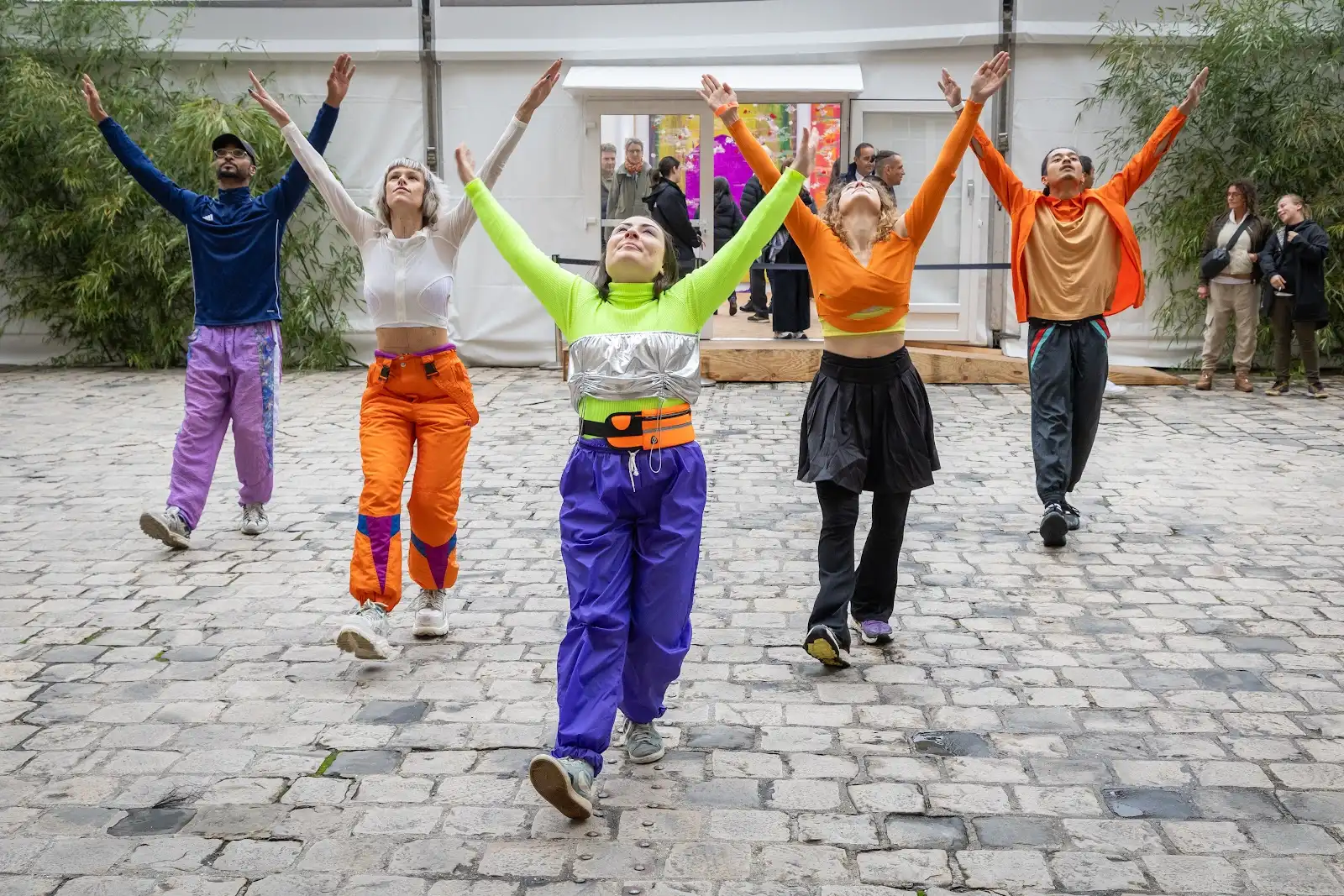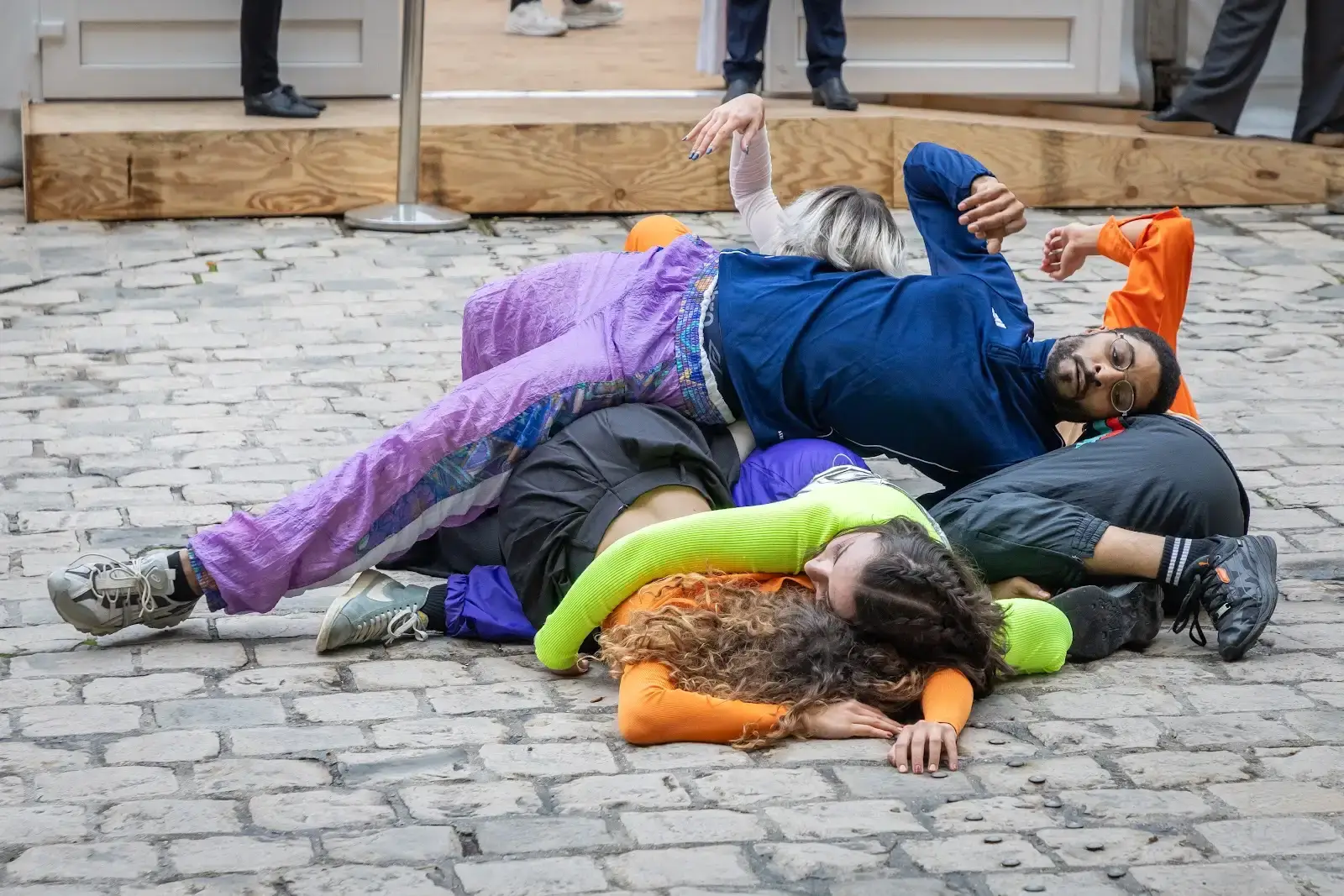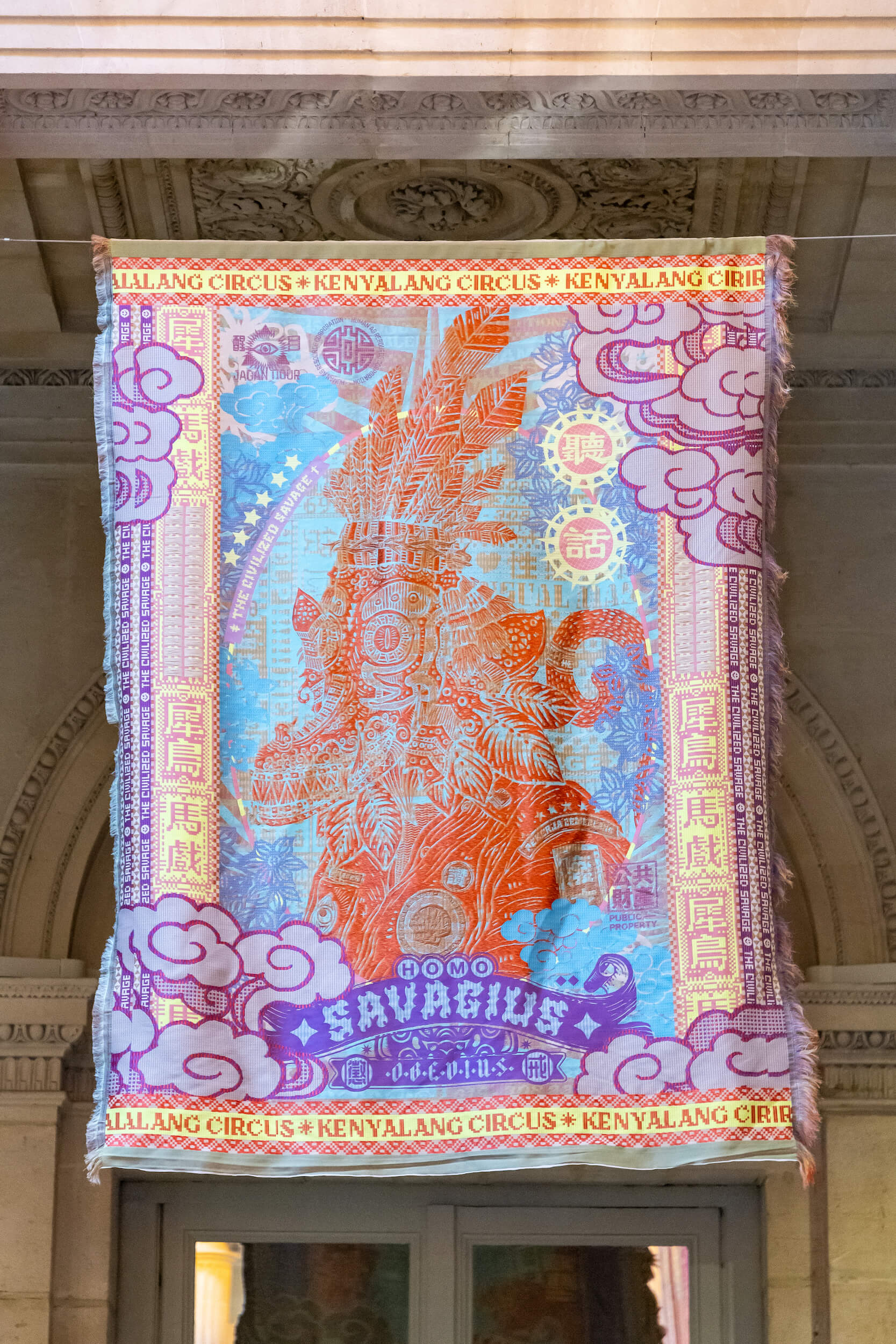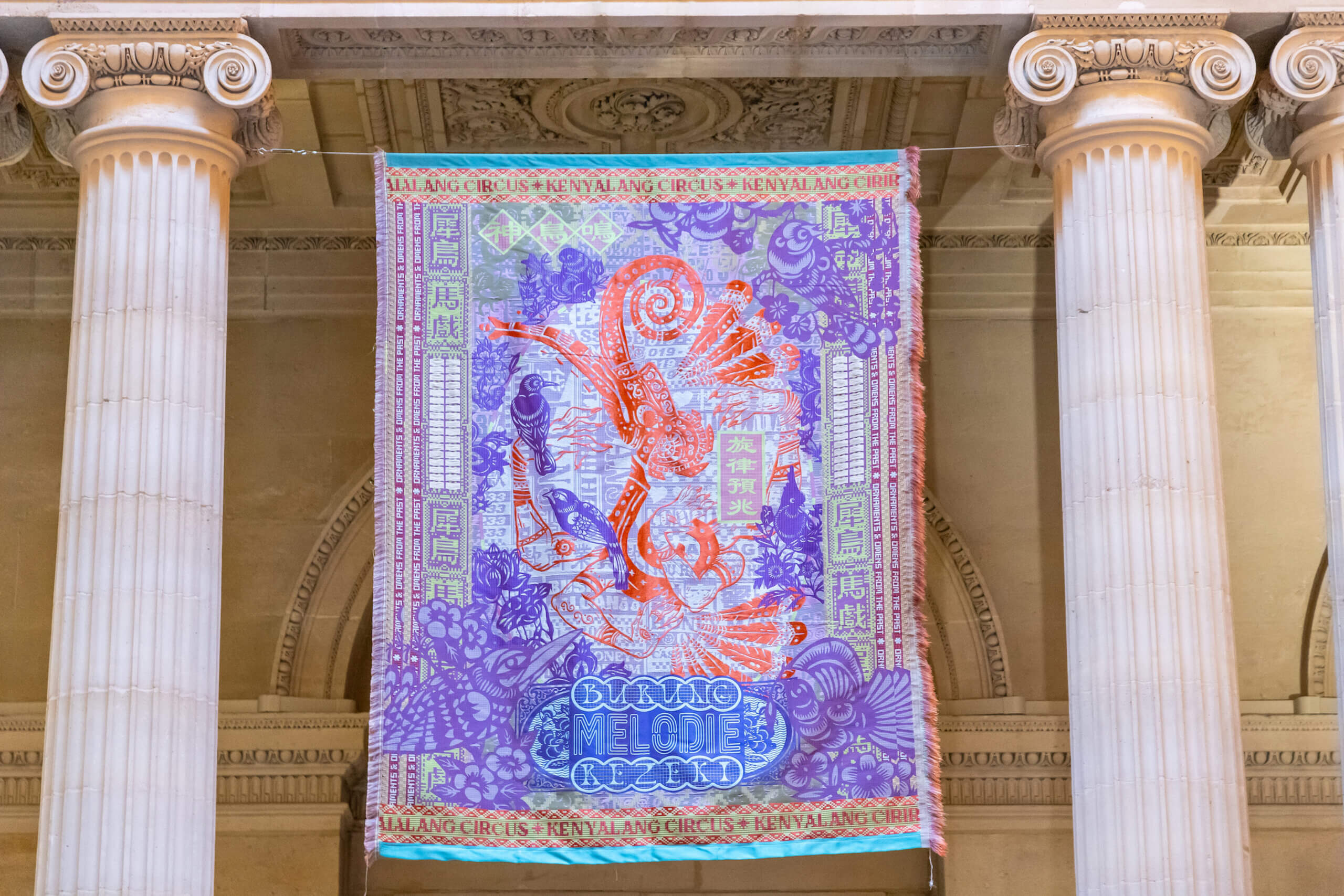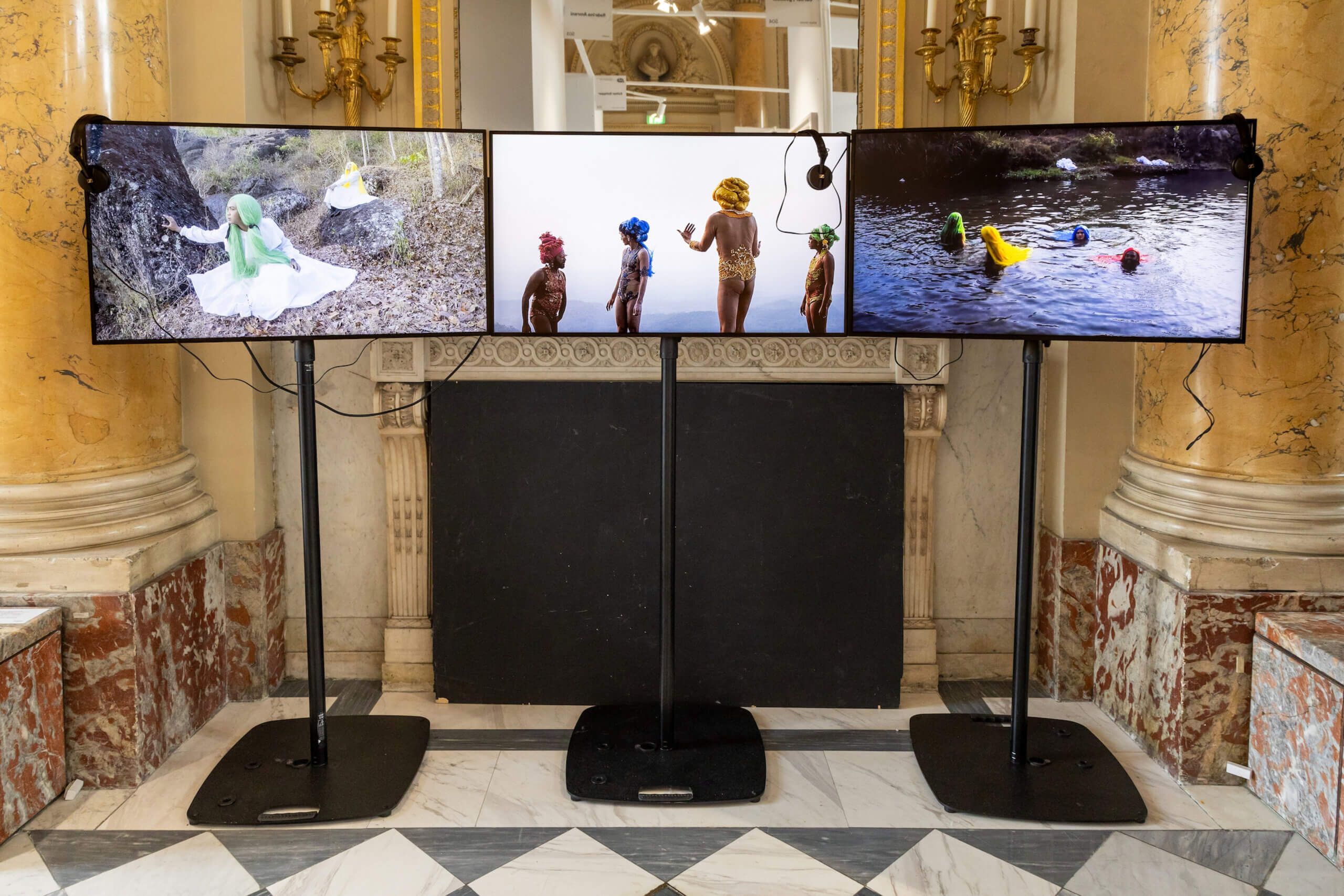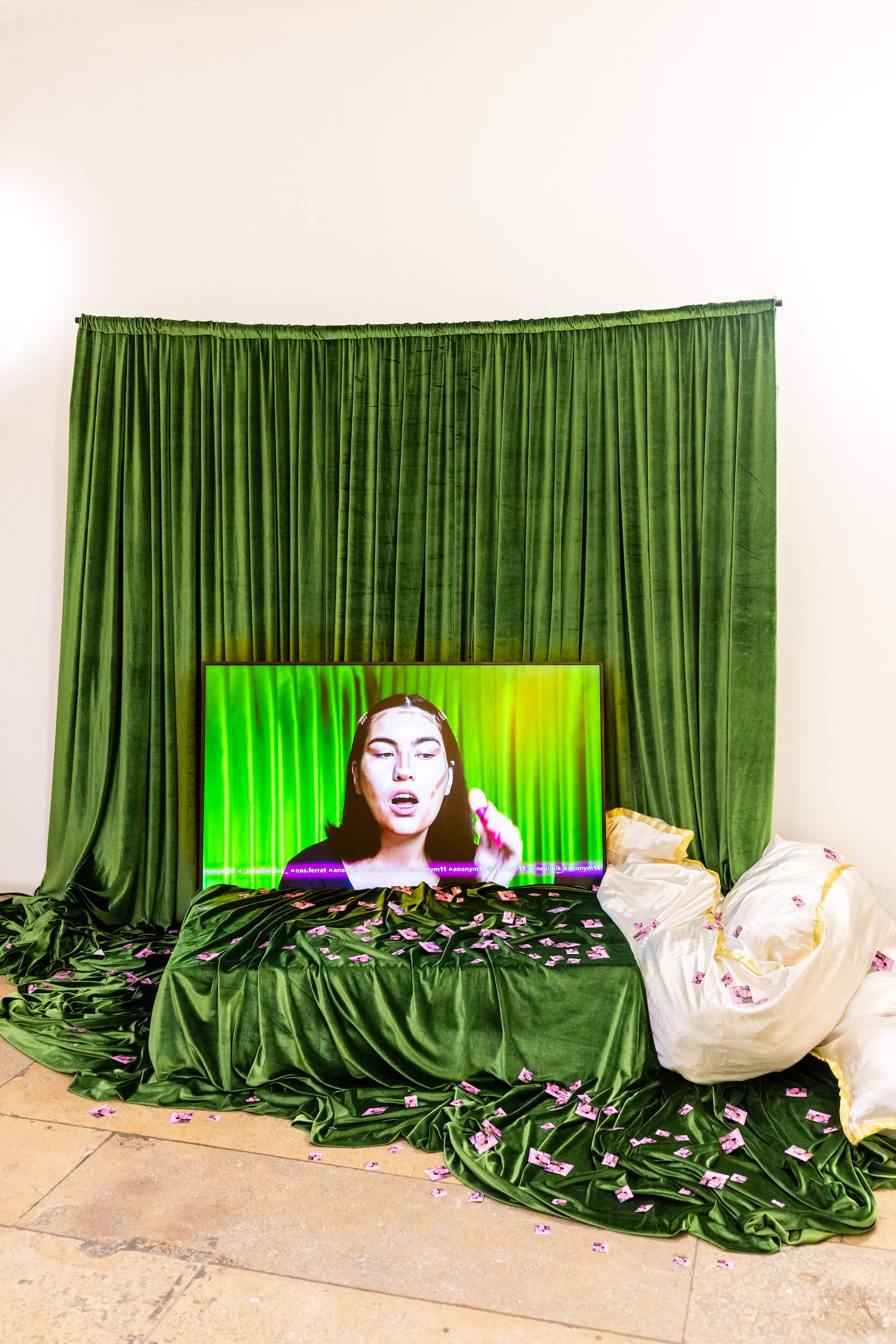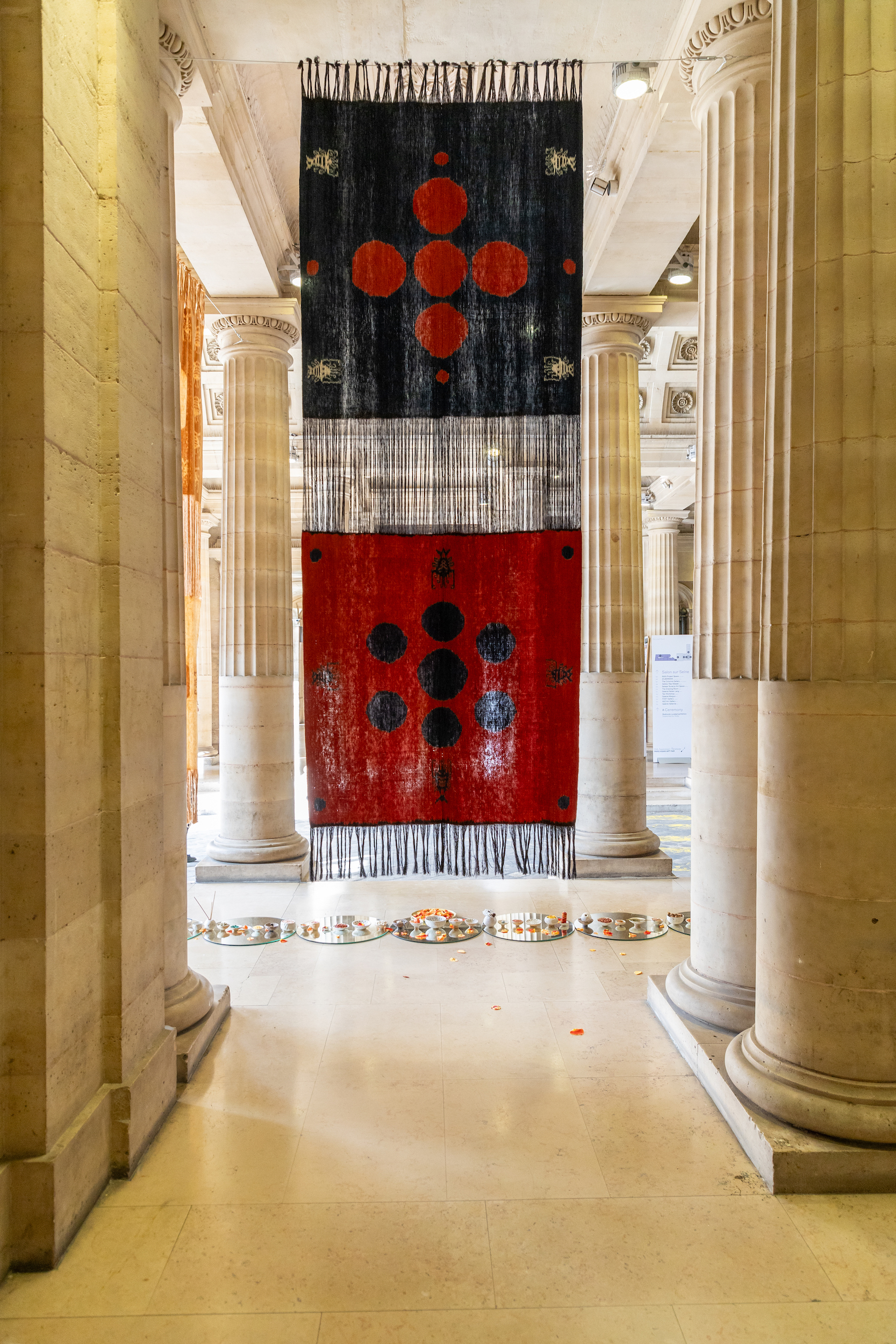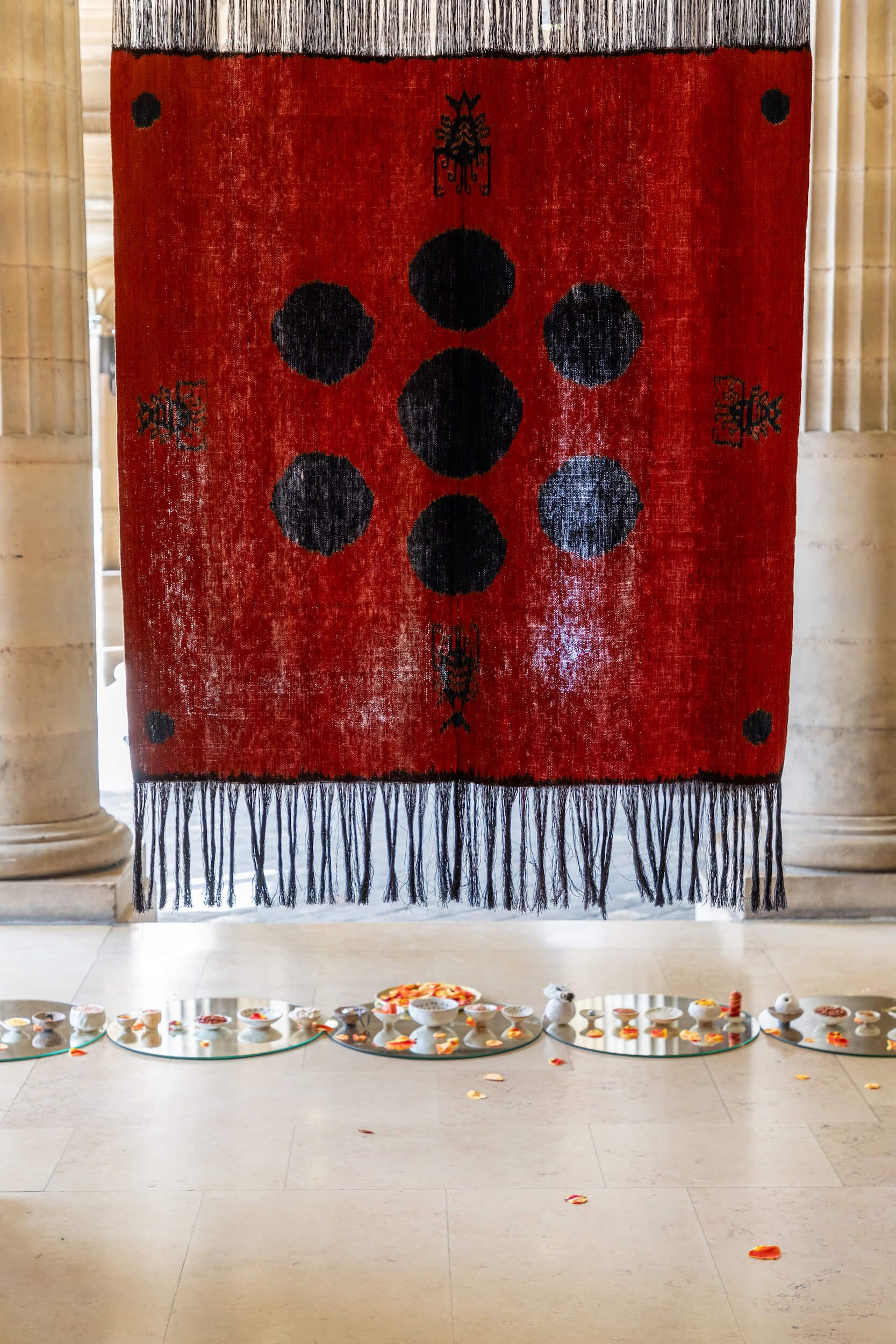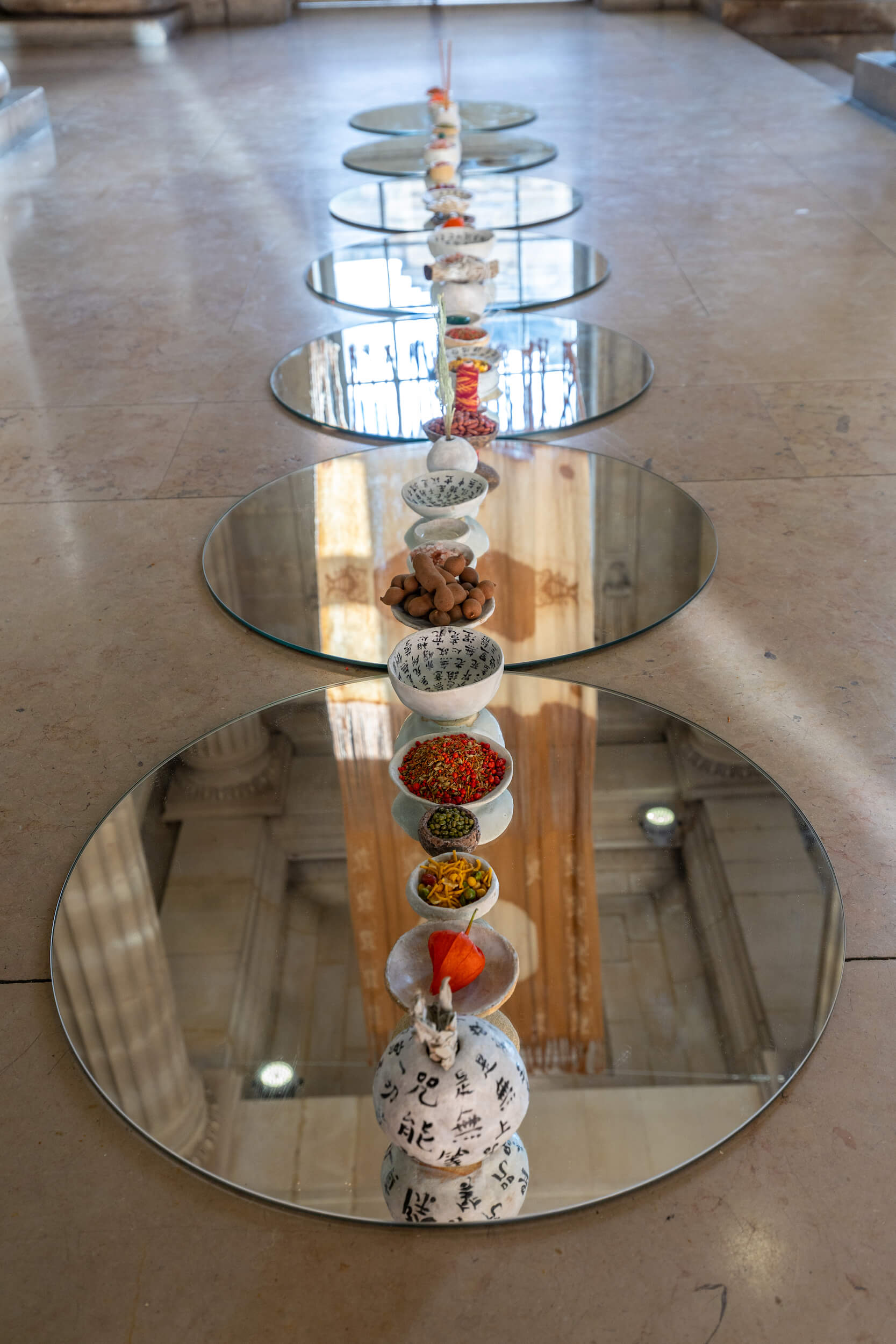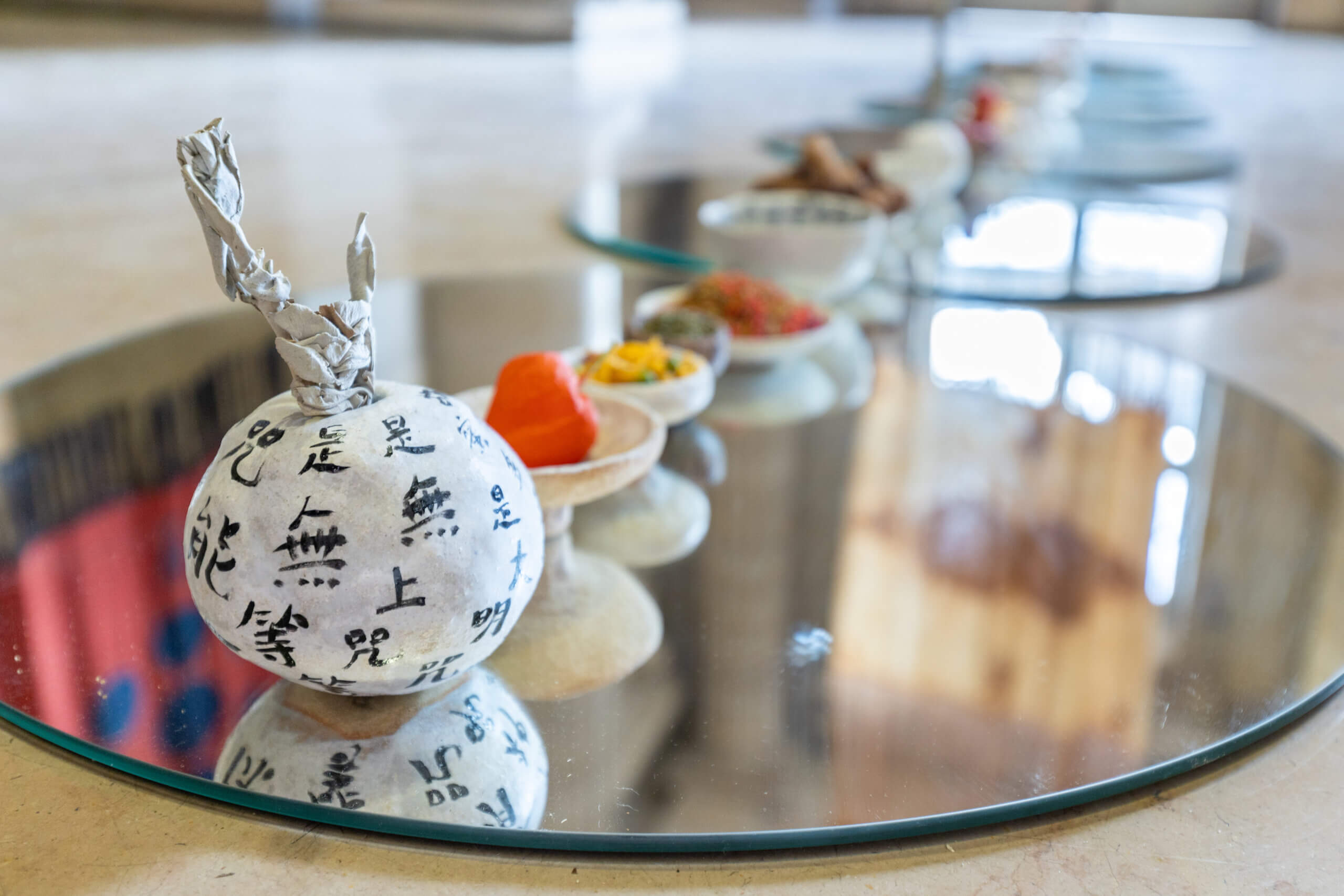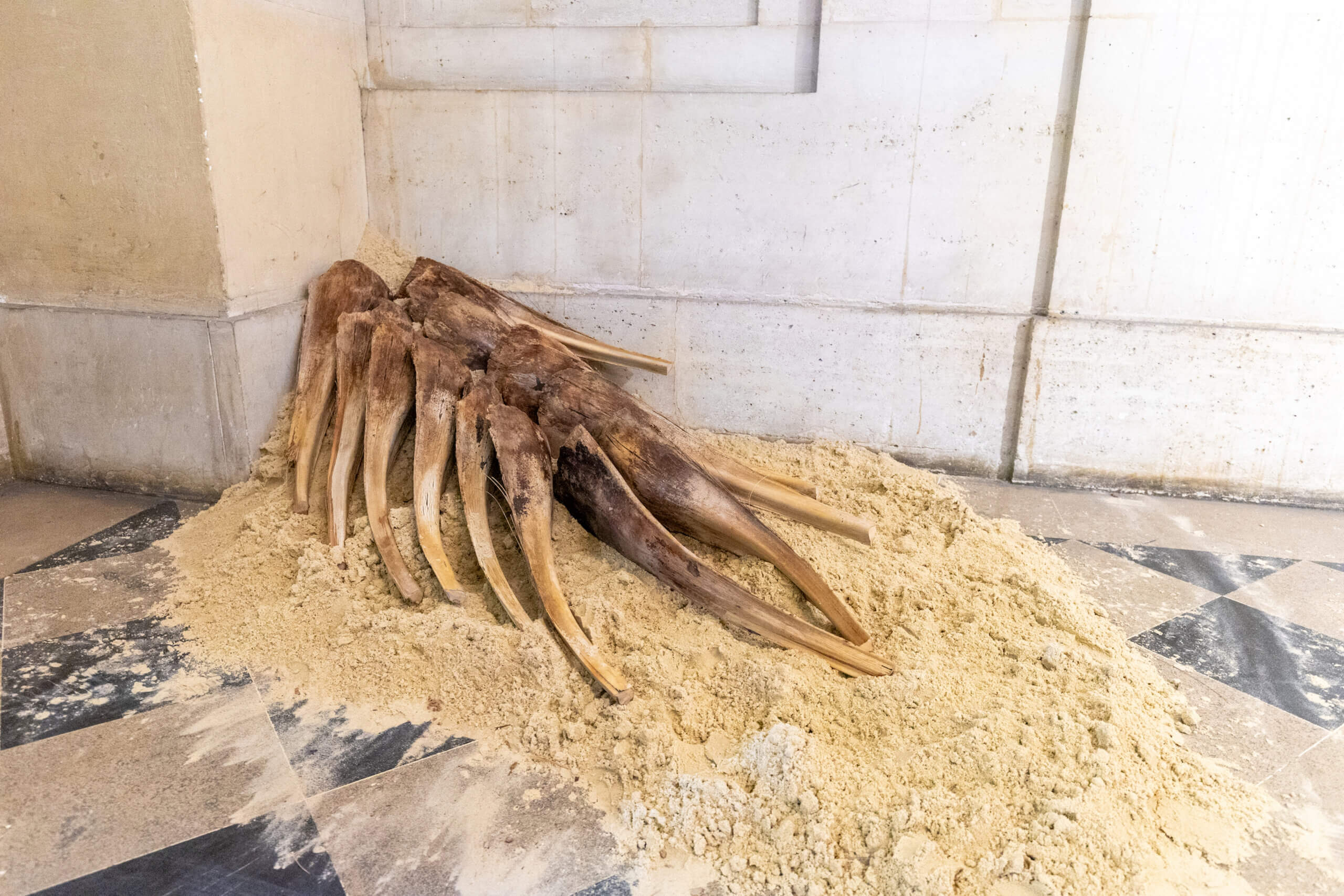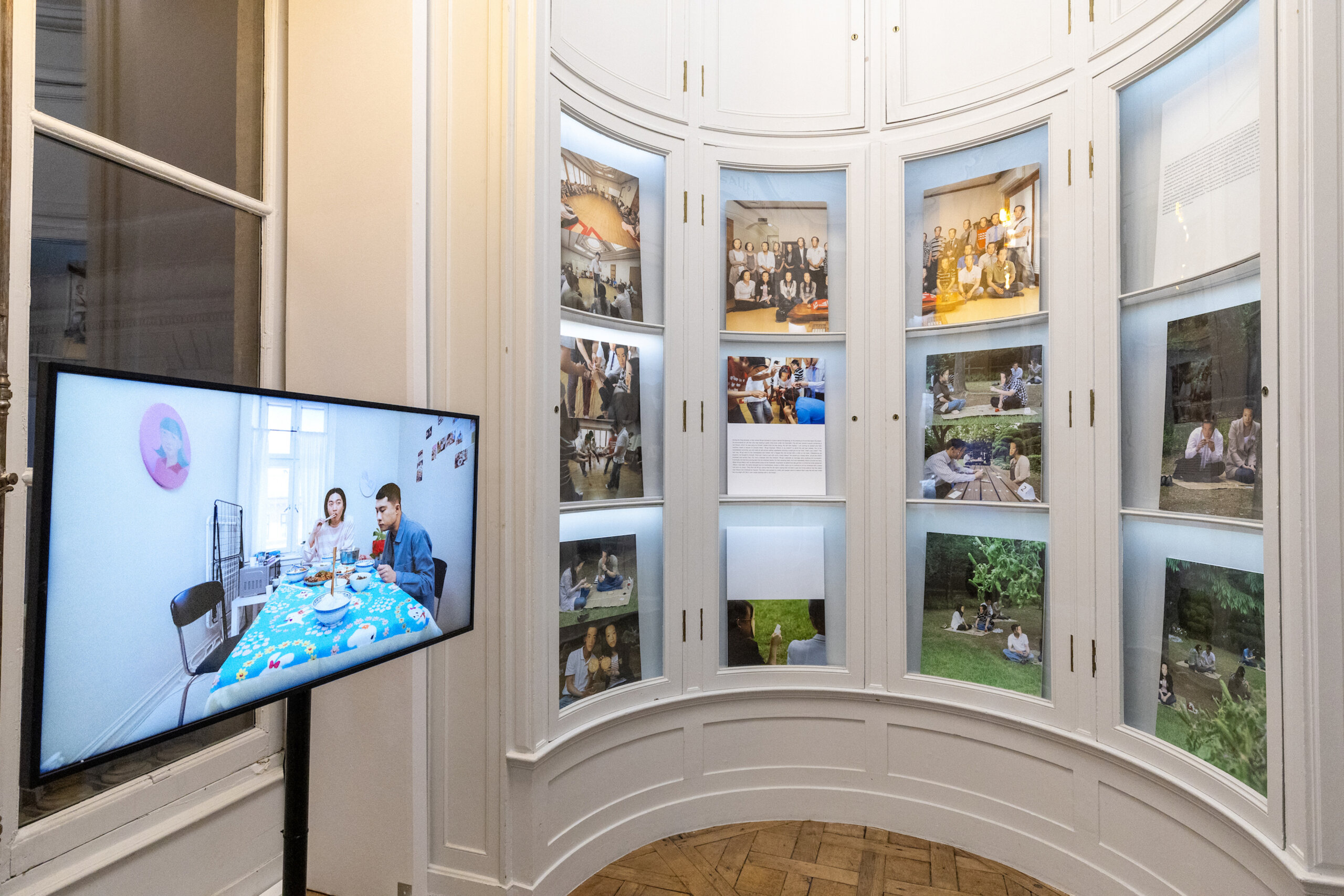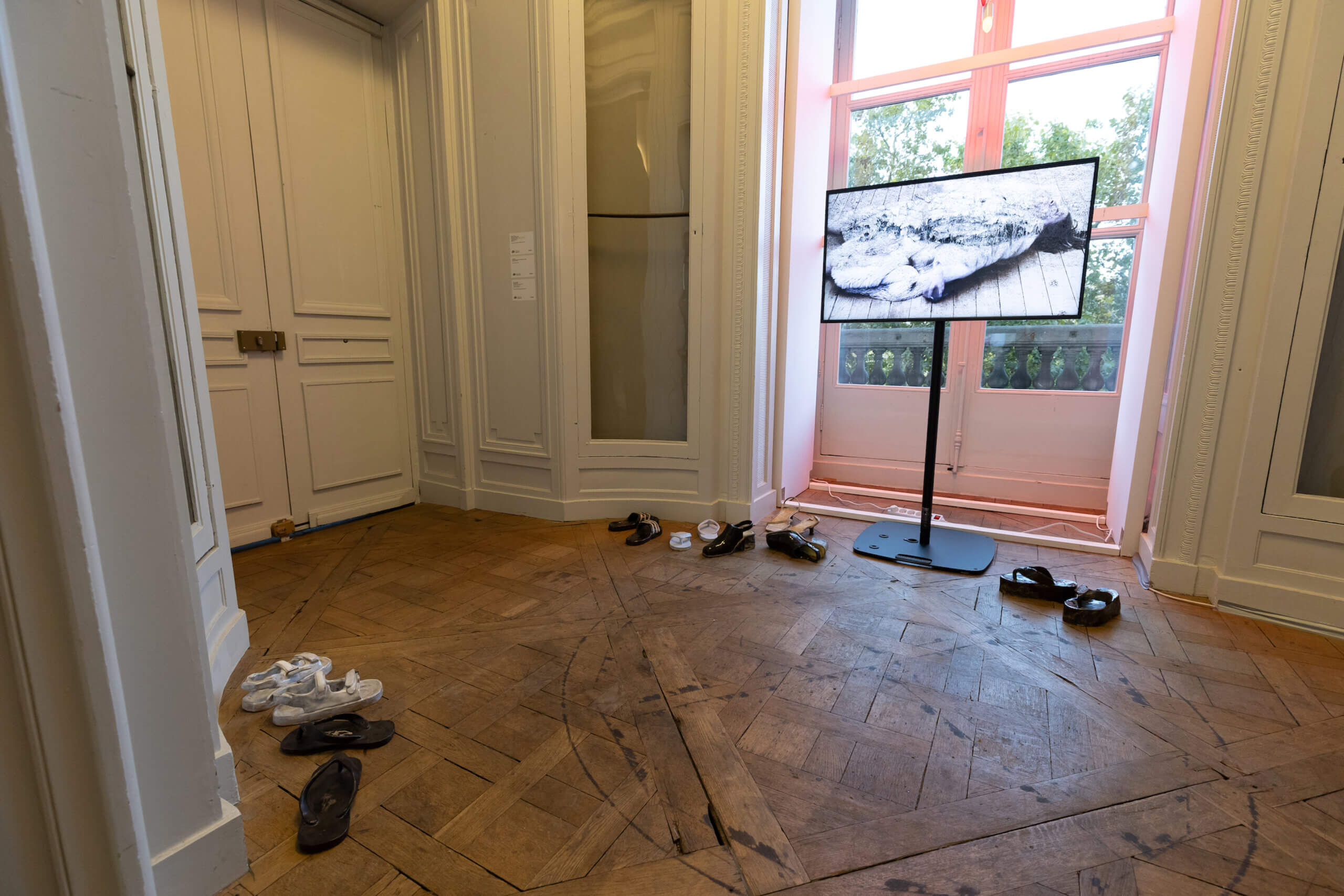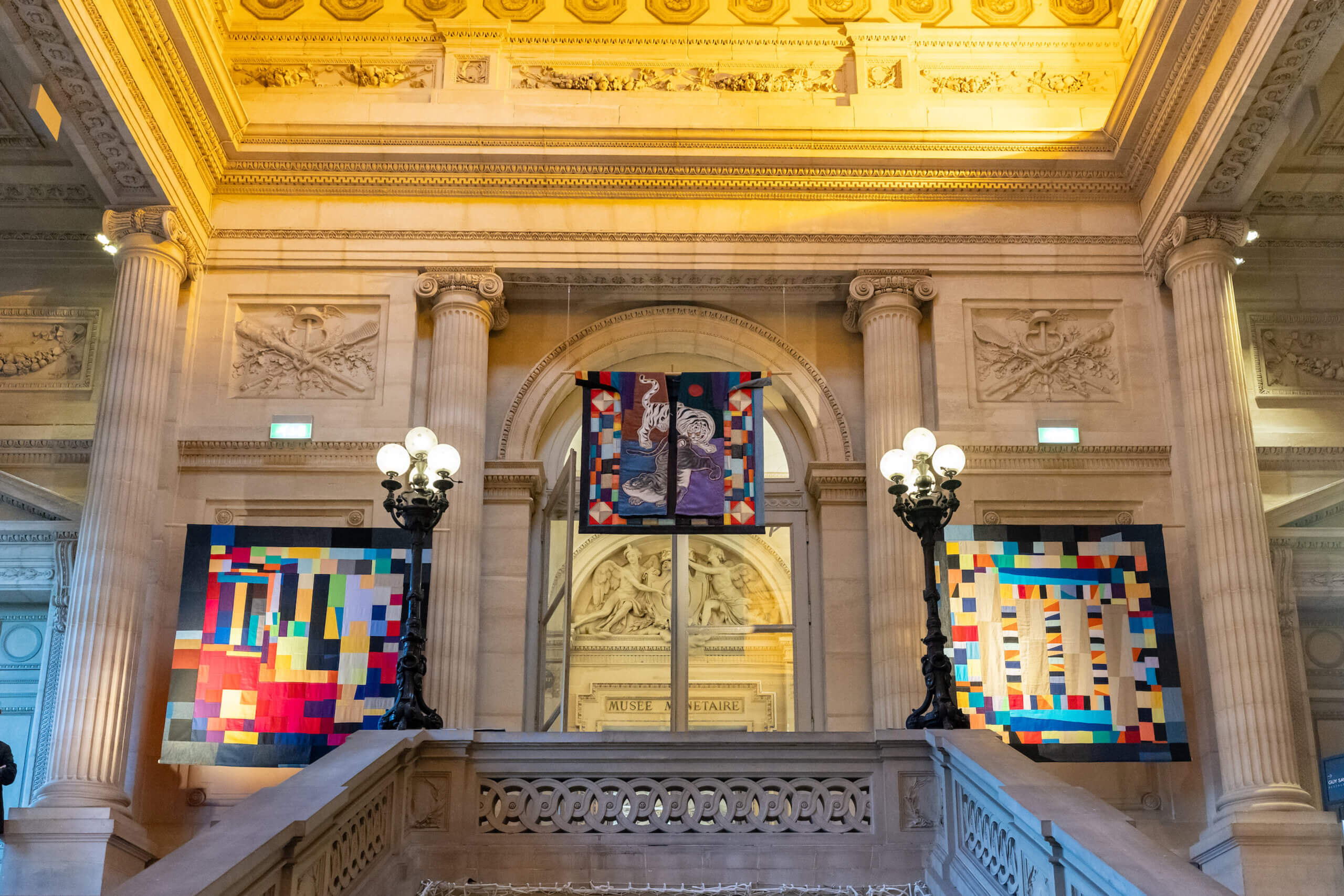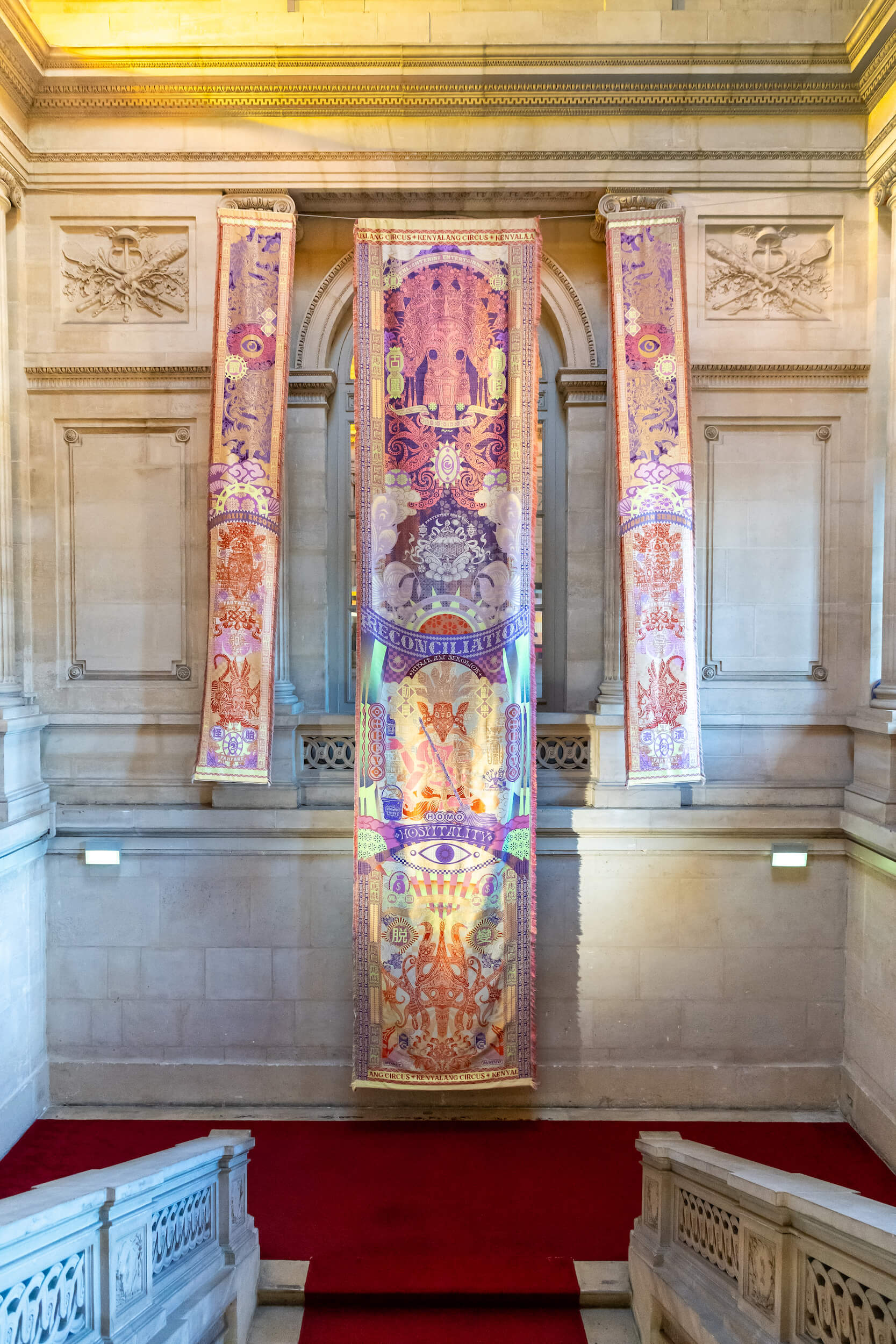Darius Dolatyari-Dolatdoust, Charwei Tsai, Marcos Kueh, Leelee Chan, Zadie Xa, Trevor Yeung, Nil Yalter, Minja Gu, Qian Qian, Özlem Altın, Yohan Han, Natsuko Uchino, Ariuna Bulutova, Tomoko Sauvage, Isaac Chong Wai , Mohammad AlFaraj, Farah Al Qasimi, Faina Yunusova, Ming Wong, Yao Qingmei, Bobby Yu Shuk Pui, Hamid Shams, Nina Jayasuriya, Minja Gu, Rain Wu.
The main exhibition of the 10th edition of Asia Now is an international curatorial project that features 25 artists, who shine a light on the concept of ceremony, weaving rituals with art, philosophy, science, and poetry. A ceremony is usually composed of a prescribed sequence of actions, words, and artifacts, frequently enacted at rhythmic intervals, whether daily, weekly, or annually, or during significant milestones. While the term “ritual” traditionally evokes images of solemn religious rites, the ceremony opens the door to the cultural practices embedded in daily existence. From cooking rituals to the communal exuberance of festivals, these moments pulse with significance, bridging the sacred and the mundane.
The exhibition represents a diverse reflection on the notion on ceremony in our life and positions ritualistic engagements as both a celebration of ancestral wisdom and a critical tool for interrogating and redefining established traditions and power dynamics. Rituals embody human actions that not only reinforce social structures but can also transform them. The artists invited by Radicants delve into the unifying power of communal celebrations—encompassing dances, processions, and festivities—as vessels for interpreting the shared human experience. Charwei Tsai’s participatory project sets the tone. The perishable offerings, hand-inscribed with mantras inside the vessels proposed by Charwei Tsai in her participatory installation in the entrance area of the peristyle of La Monnaie, serve as a gesture of gift-giving for the visitors of the art fair that benefits the collective well-being of all sentient beings. The hybridization of all the flags that make up the origins of Darius Dolatyari-Dolatdoust (France, Iran, Germany, and Poland), who designs costumes as choreographic proposals, offers a reason for ceremonial transformation—the disappearance of the human body under the costume and its metamorphosis into a different type of creature. Mohammad AlFaraj’s video projection Ghost of the Fallah is a poetic visual essay on the slow-paced life of the last remaining farmers wholeheartedly cultivating the last remaining usable plots in the artist’s hometown, once home for the largest water oasis and oil fields in Saudi. Paired with the palm tree sculpture and spectacular installation in the peristyle, the film that searches for that supernatural and emerging soul, mixed with the components of the world’s natural mosaic and the repetitive ceremonies of the mundane life. The series of Marcos Kueh’s tapestries is inspired by the idea of foreign identities versus the performative expectation of the Western gaze. His colorful and massive woven posters and billboards allude at the same time to the gathering of creatures of the tropics for a ceremonious celebration of a bizarre culture and to the criticism of exotic imports and the ritual of grief concerning the invisibility of our problems in the eyes of others. Zadie Xa draws upon her Korean-Canadian background to inform an ongoing engagement with hybrid and diasporic identities, global histories, and folklore, as well as spiritual and religious rituals to elevate narratives that have been erased and repressed by the West and occupying powers. Her textile pieces, inspired by embroidered hanboks, items of traditional Korean clothing, are reminiscent of both indigenous North American quilting and the Korean bojagi tradition, which has itself been compared to the work of modern artists such as Piet Mondrian and Paul Klee, and are dedicated to honoring and “re-remembering” the work of the artist’s ancestors. In contrast, Minja Gu arranged a ritual of group matchmaking for unmarried men and women over the age of 30 on May 30, 2010, to blur the boundaries between mundane life and artistic projects. Nil Yalter performs in her video a shamanic ritual with electronic sounds, acting as an homage to female shamans—of whose existence she learned in Siberia. Her approach seeks to remind viewers of the necessity of opening oneself to uncoded forms of knowledge outside the Cartesian framework, getting in touch with ancient, indigenous consciousness in order to trace the unrevealed sources of female power and its potential for transgression.
Ceremonious assemblies manifest universal social forms that resonate across diverse cultural landscapes, prompting artists from Asia and beyond to reconnect with ancestral roots, explore diasporic narratives, and revive forgotten traditions. In a globalized world, this artistic dialogue posits unity as a remedy for contemporary estrangement, advocating for interdependence over isolation and conflict. Nina Jayasuriya’s artistic practice reflects on our use of everyday objects, and on the significance of sacredness and the reappropriation of heritage, as part of an ongoing construction of intimate environments and personal myths. Her series of ceremonial shoes (which is the depiction of the shoes put off by religious people before entering a temple) dispersed through the exhibition space, indicate on the fine line between rituals and everyday life, dissolved into the fabric of everyday life. Aryuna Bulutova turns to Indigenous practices and epistemologies in a quest to heal our relationship with the world beyond the human. Inspired by Lusuud, a Buryat shamanic ritual, and guided by her parents, who are practicing shamans, Bulutova’s video and installation work interweaves ancestral knowledge with climate awareness. Özlem Altın’s collaged imagery depicts a central figure, which seems to connects the earth with the sky and relates either directly or metaphorically to the sacred ancient rituals that have been performed according the rhythm of the year’s season, like for instance the Equinox. The visual core of Qian Qian’s paintings draws from symbols endemic to the microcosms of electromagnetism and molecular biology, akin to micro-landscapes probing the harmony and chaos within this internal universe, which engages in a ritual of spiritual metamorphosis. Leelee Chan’s enigmatic sculptures incorporate urban debris, ancient artifacts, natural materials, and industrial and mundane products and look like the props for the unknown strange ceremonies. Tomoko Sauvage’s sonorous timepiece, assembled with underwater glass sculptures as a metronome for poly- pulsating music and meditation on a ritual of slowing down time, and Natsuko Uchino’s ceramic bowls and glass objects, which revisit the history of techniques and know-how by thwarting the hierarchies between disciplines, as well as Trevor Yeung’s sculptures and lighting systems, serve as instruments and props to be activated in speculative rituals to be imagined by everyone. Farah Al Qasimi’s film Surge explores the nature of desalination technology and its effects on marine life through the fictive narrative of a mermaid and a woman who fears the water as a metaphor for the environmental impact of daily rituals of coastal city economies. It is a short, essayistic film that pulls material from YouTube and TikTok and combines it with first-person storytelling.
Within the exhibition’s intermediate spaces at La Monnaie, the artistic practices on display engage in earnest inquiries into the rituals of conviviality and social connectivity. The work transcends mere representation, exploring ceremonies through shared experiences, mutual care, and the exuberant expressions of life. At the heart of this exhibition lies a profound motif: cheerfulness as a survival strategy intertwined with the healing power of social connectivity. It invites contemplation on how artistic expressions can facilitate the processing of loss and trauma, particularly in these times marked by conflict and political upheaval. Ultimately, Asia Now stands as a vital testament to the enduring necessity of ceremonies in fostering empathy, resilience, and a shared vision of a more interconnected existence. Yohan Han’s choreographic performance aims to investigate community, trance states, the fluid body, and the extent of bodily sensation expansion and (de)evolution through dance, revealing the deep connection between Korean agricultural society and its spiritual and cultural life, highlighting how the lunar calendar influenced seasonal activities and communal traditions. The story in Bobby Yu Shuk Pui’s Daddy’s Dinner film unfolds as three friends living together in a cozy Oslo apartment exchange cherished family recipes, symbolizing their shared experiences and deepening friendships, so the friends find solace in cooking and sharing meals, symbolizing their resilience and the enduring strength of their friendship. “Dinner-table politics” metaphorically represents the power dynamics and relationships in intimate settings, where food- sharing depicts love and care. Taiwanese artist Rain Wu’s video As Above, So Below makes use of archive images and microscopic photography of edible substances—fruits, vegetables, grain, fish, vitamins—as a metaphor of the macro, to create a timeless, scaleless world. The artist is preoccupied with the social role of food which spans across all aspects of our lives, from the most profane everyday nourishment to the sacrifices that made an anthropological imprint on the collective psyche. It connects science and myth, known and unknown. The meal, the settlement, the landscape, the cosmos, down to the microbial and viral in our guts and in the air—food allows us to discover a new perspective on our world. 3-channel video “Aku Akan Bertahan / I Will Survive” Ming Wong transposes the characters, narrative, and location to Jogjakarta in Java, Indonesia – notable for its long history and religious evolution that intersects Buddhism, Hinduism and Islam – so the work taps into a larger, older, shared regional history – far older than notions of colonial Australia or Singapore. Three artist’s collaborators who also work with Drag learnt a choreography that combines classical Javanese dance, Dangdut (Indonesian Pop) and hiphop (with a nod to Beyoncé Knowles), set to Gloria Gaynor’s anthem I Will Survive (immortalised in the film Priscilla) in a new version devised with an Indonesian Street band of “Angklung” musicians improvising on their bamboo instruments.
The four performers can be seen as Victorian schoolgirls wandering amongst ancient volcanic rocks, or as nymphs bathing in mystical waters, or as decorated (drag)queens conquering the mountains overlooking the lands. Crowned with wigs made of recycled plastic raffia in bold primary colours, the four figures are a mix of Javanese decoration, drag queen kitsch, children’s television, classical European painting, Cosplay, etc – blurring the lines of ethnic or national belongings, and between high and low culture.
With the generous support of ATHR Gallery, carlier gebauer, Capsule Shanghai, Galerie Allen, Jean-Claude Maier, Kamel Mennour, KLEMM’S, NIKA project space, PARLIAMENT, Richard Saltoun, Ron Mandos, mor charpentier, Simine Paris, Thaddaeus Ropac, The Pill ®, VI, VII, and Zilberman, The Third Line.
The Asia NOW curatorial platform is supported by Sisley.
The exhibition features the performance program including the works of Yao Qingmei, Isaac Chong Wai, Hamid Shams and Darius Dolatyari-Dolatdoust.
Performances:
An immersion in rituals
MORNING EXERCISE: “THE RISING SUN”, Yao Qingmei
With dancers: Aude MANZANO, Valentina PERUCH, Hpone SOE, Adrien SPONE, Asia TORREGGIANI and DJ Kevin Table aka k-Neu.
This project will launch a Radio Calisthenics performance during the art fair. The artist collaborates with the dancers to deconstruct the symbols of Radio Calisthenics and offer morning exercise workshops for the public. Chinese Radio Calisthenics originated in 1951, and there are now more than ten different choreographies. Radio Calisthenics is not only a form of physical exercise; its costumes, postures, and musical style also reflect a socialist ideology — “Strengthen the Body for the Revolution.” It embodies multiple ideological themes such as collectivism, revolutionary spirit, positive futurism, and national fitness. These ideologies have permeated daily life through the promotion and popularization of Radio Calisthenics.
Thursday 17, October. 1:00pm Friday 18, October. 2:00pm
DIE MÜTTER, Isaac Chong Wai
supported by ZILBERMAN
Isaac Chong Wai’s performance “DIE MÜTTER” explores themes of motherhood, heritage and intergenerational transmission. Through a visual and poetic approach, the artist challenges social and cultural norms and invites the audience to rethink familial bonds and identity. The performers move in a circle and sing lines from songs, including dirges and lullabies in various languages directed by musician Dagmar Aigner, who has been working with mourners for over 10 years in Munich. Revolving around the ideas of death, birth and motherhood, the work, named after Kollwitz’s woodcut “Die Mütter”.
Thursday 17, October. 3:30 pm
GAME OVER, Hamid Shams
supported by Simine Paris
This powerful evocation of the ancient Persian mythological tale of Fereydoun and Zahhak skillfully blends the timeless story from the Shahnameh with the contemporary struggle for freedom in Iran. Through this fusion of ancient mythology and modern resistance, the performance aims to inspire and engage audiences around the world by shedding light on the universal pursuit of justice and equality.
The story of Zahhak and Fereydoun originates from the depths of Persian mythology, specifically from the Shahnameh (“The Book of Kings”), a monumental work by the poet Ferdowsi, written around the 10th century, a timeless narrative where moral and political questions echo across the centuries. The episode of Zahhak’s downfall and Fereydoun’s rise is fundamentally a mythological tale, but it carries with it universal themes deeply rooted in Persian culture and history: relentless tyranny, the triumph of justice, and the legitimacy of power.
Zahhak is a legendary figure, both dark and terrifying. He is depicted as a formidable tyrant, marked by a monstrosity that is both physical and moral: terrifying serpents grow from his shoulders, demanding to be fed with the brains of young men. This gruesome detail symbolizes not only his extreme cruelty but also the insatiable and dehumanizing oppression he imposes on his people. Zahhak’s reign, the embodiment of absolute tyranny, represents the peak of destructive power, where authority is wielded through violence and fear, and where freedom and life are sacrificed to an endless cycle of destruction.
In contrast, Fereydoun stands as the archetypal liberator hero, the champion of justice and the people. In a world engulfed by the despotism of Zahhak, Fereydoun embodies the hope for renewal. Supported by the will of the oppressed, he rises against the tyrant. His victory over Zahhak marks not just the end of a reign of terror but the beginning of a new order founded on justice, peace, and prosperity. Fereydoun’s reign is seen as a golden age, where balance and harmony are restored.
Thursday 17, October. 7:00 pm Sunday 20, October. 5:00 pm
FLAGS PARADE, Darius Dolatyari-Dolatdoust
Darius Dolatyari-Dolatdoust is an artist, performer, choreographer and designer, from a Franco- German-Polish mother and a Franco-Persian father. He lives and works between Brussels and Marseille.Since 2021 he has created his company DDDMM with Maureen Béguin-MorinAfter studying Fashion Design at the Duperré school, Graphic Design at the Estienne school in Paris, sculpture at La Cambre, he finally studied dance, performance and choreography within the Institute of Choreographic Arts – (ISAC) in the Royal Academy of Fine Arts.His approach revolves around the making of costumes, which he considers in turn as a space for transformation and hybridization, a choreographic score, in its capacity to modify our relationship to the body, to dance and to language. The garment becomes a means of questioning his identity, whether by summoning his Iranian origins, by donning costumes inspired by Persian works in the Louvre, or by deconstructing our relationship of domination to other species, by imagining hybrid creatures at the border of the human and the animal. As a Visual Artist is main medium is textile, which he use to make patchworks, paintings, costumes and scenographies. His patchworks are like stories, trying to catch a moment of movement, often between fighting and loving, between violence and love. Bodies are melting in which other, becoming shape of colors inside the patchwork. These textile works are also used for setting up installations, activated by site-specific performances. He has designed the costumes and scenography for the creations of Pau Simon (La grande remontée), Liam War-ren (Merge), Grégoire Schaller (Ekkrino, Mata, Ordeal by water) and Renaud Dallet (Voir, toucher, s’aimer fort).
Could we consider disappearing as a human species? The performance Flags Parade imagines this impossible hypothesis until grotesque: to hide the contours of our bodies in a flamboyant camouflage, not to disappear, but to appear differently. The color scheme of the costumes is made up of deconstructed flags of 4 countries, Iran, France, Poland and Germany, which make up the national identity of the artist, who offers a look at the mixture of different cultures in his home through queer optics. Are you European or Asian? A local or a migrant? Or perhaps you are no longer human at all, but some other non-human being whose identity was lost somewhere in the process of cultural translation? Metamorphose bodies through costume, transform movements and offer the dancer a new way of appearing and expressing himself. Flags moving? Colourful birds? Hybrid creatures try to communicate with each other: in spaces, they seek each other, trying calls, turn around, to finally meet in a final parade, a cry of love.
Saturday 19, October, 1:00pm
ANCIENT DESIRES – ONE TASTE, Charwei Tsai
Supported by mor charpentier
Geographical, social, and spiritual motifs inform the practice of Taiwanese artist Charwei Tsai, which encourages viewer participation outside the confines of complacent contemplation. Preoccupied with the human/nature relationship, Tsai meditates on the complexities among cultural beliefs, spirituality, and transience. The new participatory installation created specifically for the 10th edition of Asia Now will greet the visitors right in the entrance area: the perishable offerings, hand-inscribed with mantras inside the vessels proposed by the performers to the visitors, will serve as a gesture of gift-giving that benefits the collective well-being of all sentient beings. This project is the new iteration of Tsai’s “Ancient Desires – One Taste” created earlier this year In collaboration with the local community of Licchavi House in Kathmandu, founded by the world renown Bhutanese Buddhist teacher and filmmaker Dzongsar Khyentse Rinpoche.
Thursday 17, October. 10:15am

